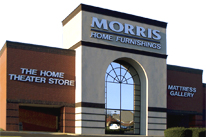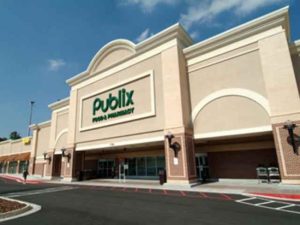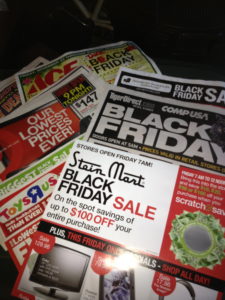BRANDING IS MUCH MORE THAN ADVERTISING – WHY RON JOHNSON FAILED AT JCP
PRESS PLAY>> TO VIEW KEN’S WELCOME MESSAGE FROM FRANCE.
With the ongoing poor results reported by JC Penney over the past several months, it came as no surprise to me as I arrived in France a couple weeks ago to learn that he had been fired. No matter how good your resume is, non-stop double-digit declines in revenues and profits—and the resultant plummeting of the stock price—Johnson couldn’t expect to survive the uproar from the board, Wall Street and long-time customers. I’ve written about the branding makeover at JCP a couple times this past year, but I felt it necessary to give one more opinion on why the guy who was so successful at Apple just couldn’t make it happen at a conventional department store.
First, let’s look at what Johnson had at Apple. First, Apple is a brand that was truly differentiated from the competition. Cutting-edge design. Breakthrough technology. Futuristic apps and products. These were all in place before he was so successful at Apple. Taking the brand principles that were in place and applying them (very well I must admit) to the retail operations for Apple truly set the stores up as a model for a consumer centric experience and one where the people, the design and the operations lived up to the brand promise everyday.
Second, Johnson had a strong, brand evangelist as a leader in Steve Jobs. While he was demanding and relentless, Jobs set a standard that people half as smart as Johnson would have succeeded by following. No such leadership existed at JCP. Johnson’s predecessors were traditional department store veterans who chose more to emulate and copy stores like Kohl’s and Macy’s and really never stood out as anything special. Business was built on ongoing promotions and awareness and while that generated volume, it didn’t develop a hallmark brand that the board wanted when it hired the new regime last year.
Third, JCP had built its growth in recent years on these promotions and coupons but failed to develop a loyalty to the stores and the people that quickly evaporated as soon as Johnson’s team adopted a new, everyday (somewhat) low price strategy. As I have written in this blog before, the mistake was to go to the extreme. JCP should have maintained a consistent (reduced) promotional plan to maintain it’s loyal sale shoppers while it developed the look and messaging that would have differentiated it from the other department stores.
Apple didn’t have to have sales because it built its brand on the products and the service that were so far above the competition. JCP had to gradually climb out of the hole it had dug for itself over the years with me-too advertising.
Ron Johnson, Michael Francis and the others in this new regime didn’t suddenly get dumb when they got to Plano. No they just tried to apply the principles of a strong brand to one that needed a lot more repair than they bargained for.

 Unfortunately, I don’t believe any advertising—no matter how creative or well placed it is—can make up for the lack of a meaningful brand strategy. Despite all of the aggressive ads, Sears simply isn’t a factor to the consumer anymore. In many of the groups that I present to or work with, I ask the question “How many of you have shopped or considered shopping at Sears over the past 6 months?” The answer is almost universally a resounding “None!” It’s hard to believe, but what was once the #1 retailer in America is no longer a factor for most customers these days. If you wonder why this happened, I suggest considering what Dr. Len Berry of Texas A&M wrote many years ago about what successful store have in common. The number one trait that the hot stores shared then—and now—is that they have a reason for being. And that reason is not just because there are other retailers who offer the same merchandise and services in a similar box. It’s a real reason for existing and for being firmly entrenched into the shopping lists of many consumers. Ask yourself (unless you work there) if Sears disappeared tomorrow, would you really miss them? Would you wonder where you were going to shop for appliances, tools, paint, automotive supplies and service? All of these were distinguishable strengths that Sears once maintained in the marketplaces. They not only were top of mind, but they were almost synonymous with these categories in their heyday.
Unfortunately, I don’t believe any advertising—no matter how creative or well placed it is—can make up for the lack of a meaningful brand strategy. Despite all of the aggressive ads, Sears simply isn’t a factor to the consumer anymore. In many of the groups that I present to or work with, I ask the question “How many of you have shopped or considered shopping at Sears over the past 6 months?” The answer is almost universally a resounding “None!” It’s hard to believe, but what was once the #1 retailer in America is no longer a factor for most customers these days. If you wonder why this happened, I suggest considering what Dr. Len Berry of Texas A&M wrote many years ago about what successful store have in common. The number one trait that the hot stores shared then—and now—is that they have a reason for being. And that reason is not just because there are other retailers who offer the same merchandise and services in a similar box. It’s a real reason for existing and for being firmly entrenched into the shopping lists of many consumers. Ask yourself (unless you work there) if Sears disappeared tomorrow, would you really miss them? Would you wonder where you were going to shop for appliances, tools, paint, automotive supplies and service? All of these were distinguishable strengths that Sears once maintained in the marketplaces. They not only were top of mind, but they were almost synonymous with these categories in their heyday. For example, take the case of Morris Home Furnishings from Dayton, Ohio. VP Marketing Robert Klaben provided some interesting examples of how his company was using social media to increase sales to the audience at the Main Street Session that was targeted to independent retailers. Kleben not only showed how Morris used Facebook (and other tools) to interact with their customers on an ongoing basis, but he showed how this has become one of the best measurement tools for evaluating the response to many of their promotions and loyalty building efforts. Sure, they were generating increased traffic and sales, but they have also been able to create loyalty that can be measured by the interactive responses and feedback that their customers are eagerly providing. These are not simply sales promotions, but brand building programs that are building relationships that will bring the customers back to their stores many times in the future. Granted the furniture business is not a frequent store visit experience, so you need to build an ongoing communication with your customers to be the first place they think about when the need for furniture arises. Their experiences show that the dialogue is building fast and the relationships are built on the heart not just the wallet.
For example, take the case of Morris Home Furnishings from Dayton, Ohio. VP Marketing Robert Klaben provided some interesting examples of how his company was using social media to increase sales to the audience at the Main Street Session that was targeted to independent retailers. Kleben not only showed how Morris used Facebook (and other tools) to interact with their customers on an ongoing basis, but he showed how this has become one of the best measurement tools for evaluating the response to many of their promotions and loyalty building efforts. Sure, they were generating increased traffic and sales, but they have also been able to create loyalty that can be measured by the interactive responses and feedback that their customers are eagerly providing. These are not simply sales promotions, but brand building programs that are building relationships that will bring the customers back to their stores many times in the future. Granted the furniture business is not a frequent store visit experience, so you need to build an ongoing communication with your customers to be the first place they think about when the need for furniture arises. Their experiences show that the dialogue is building fast and the relationships are built on the heart not just the wallet. It’s time for more retailers to take the same approach as Morris. It’s now expected that a retailer will have a robust website that will provide them not only a chance to get product information but also help them complete the transaction. This simply gets you into the ballpark. However, to build a strong brand relationship, social and mobile marketing can certainly accelerate the process. Remember, convenience is more important than ever and the online media help make it easier than ever before to shop and make an intelligent purchase without ever having to go to another mall. Facebook has gone far beyond being a place to share your personal experiences. It is the forum for letting retailers know what you like and how you want your purchase experience.
It’s time for more retailers to take the same approach as Morris. It’s now expected that a retailer will have a robust website that will provide them not only a chance to get product information but also help them complete the transaction. This simply gets you into the ballpark. However, to build a strong brand relationship, social and mobile marketing can certainly accelerate the process. Remember, convenience is more important than ever and the online media help make it easier than ever before to shop and make an intelligent purchase without ever having to go to another mall. Facebook has gone far beyond being a place to share your personal experiences. It is the forum for letting retailers know what you like and how you want your purchase experience. Shortly, after viewing the spot, I read the news that former Publix president and chief marketer had passed away in Lakeland, FL. In case you haven’t hear of Mark before, suffice it to say that he was more instrumental than anyone in making Publix a retail powerhouse in the southeast helping to build Publix sales from $3.2 Billion when he took over the top position to $27 Billion in just over 1000 stores in only five states. We won’t even talk about the dominant market share that Publix has built and the loyalty it has developed with its customers over the years. More significantly, however, is how Mark’s vision made Publix a brand that is part of the markets that its stores dominate. There are many factors that contribute to this strong position—well-run, well-merchandised stores in prime locations, loyal employees who love to work in a grocery store (although they don’t think of it in those terms), constant improvement in layout and design to really make “shopping a pleasure” (Publix’s long established slogan), and finally, to break-through creativity in their marketing that not only built a memorable brand, but also fought off the price competition so prevalent in this category of retail.
Shortly, after viewing the spot, I read the news that former Publix president and chief marketer had passed away in Lakeland, FL. In case you haven’t hear of Mark before, suffice it to say that he was more instrumental than anyone in making Publix a retail powerhouse in the southeast helping to build Publix sales from $3.2 Billion when he took over the top position to $27 Billion in just over 1000 stores in only five states. We won’t even talk about the dominant market share that Publix has built and the loyalty it has developed with its customers over the years. More significantly, however, is how Mark’s vision made Publix a brand that is part of the markets that its stores dominate. There are many factors that contribute to this strong position—well-run, well-merchandised stores in prime locations, loyal employees who love to work in a grocery store (although they don’t think of it in those terms), constant improvement in layout and design to really make “shopping a pleasure” (Publix’s long established slogan), and finally, to break-through creativity in their marketing that not only built a memorable brand, but also fought off the price competition so prevalent in this category of retail. That brings me to Black Friday! Once again this year, retailers have abandoned any semblance of building a brand prior to the holidays in favor of the biggest sale of the year (or so they say). Even the name—formerly a trade description for the sales and profit potential of the day after Thanksgiving—is nothing more than a big clearance type of event. And it’s not just the retail stores. Black Friday is a good time to buy a car, clean your carpets, get your teeth whitened and just about any other business that is trying to get more customers at this time of year. Don’t have anything more to say about Black Friday? Just open the store even earlier…like Thanksgiving am or maybe even Wednesday pm. As a student of retail marketing, I admit that I went through every circular in the Thursday paper and didn’t find one that really stood out. Kohl’s and JCP outweighed the others but the messages were lost in the Black Friday shouting and screaming. Kind of like driving down the Grand Strand at Myrtle Beach or A1A in Daytona. Ycccch! The broadcast was equally boring, although Target dared to be different with some silly carolers that turned me off after the 6th time of seeing the spots (in one night). It’s time to give customers a reason to shop and then have a sale that means something other than a day of the week.
That brings me to Black Friday! Once again this year, retailers have abandoned any semblance of building a brand prior to the holidays in favor of the biggest sale of the year (or so they say). Even the name—formerly a trade description for the sales and profit potential of the day after Thanksgiving—is nothing more than a big clearance type of event. And it’s not just the retail stores. Black Friday is a good time to buy a car, clean your carpets, get your teeth whitened and just about any other business that is trying to get more customers at this time of year. Don’t have anything more to say about Black Friday? Just open the store even earlier…like Thanksgiving am or maybe even Wednesday pm. As a student of retail marketing, I admit that I went through every circular in the Thursday paper and didn’t find one that really stood out. Kohl’s and JCP outweighed the others but the messages were lost in the Black Friday shouting and screaming. Kind of like driving down the Grand Strand at Myrtle Beach or A1A in Daytona. Ycccch! The broadcast was equally boring, although Target dared to be different with some silly carolers that turned me off after the 6th time of seeing the spots (in one night). It’s time to give customers a reason to shop and then have a sale that means something other than a day of the week.
Recent Comments